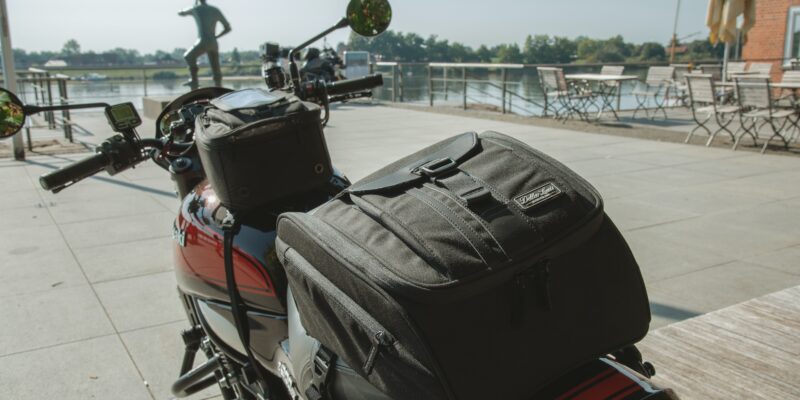If you’ve been riding for any period of time, you will have quite quickly come to the conclusion that carrying stuff on your bike can be a bit of a faff if you don’t yet have any luggage. There are many options to choose from when it comes to packing for your tour. Motorcycle luggage can be a minefield, and an expensive one if you get it wrong. Avoid some of the mistakes I made on my first bike tours, with my guide to touring luggage below.
- Choosing the Right Luggage for Your Motorcycle Tour
- Safety Considerations for Motorcycle Touring Luggage
Choosing the Right Luggage for Your Motorcycle Tour
Hard vs Soft luggage
We’ll go into the specifics of each, but to start with – let’s look at some of the basic pros and cons of soft and hard luggage.
There’s a lot to say about these things, but it basically comes down to 3 areas:
- Security
- How easy they are to manage and live with
- Rider safety
Security:
Hard luggage is going to have a marginally higher level of security. But don’t kid yourself, a determined wrongun’ with a pen knife and screwdriver can get in your hard luggage just as quickly as they can get in your soft luggage. You’ll want to keep any valuables with you rather than on the bike either way.
That said, hard luggage will always make you feel more comfortable that someone isn’t going to run off with your dirty undies while you’re paying for your petrol.
Quality of life:
Hard luggage is mostly easier to live with. It holds its shape making it easier to make use of the space. It will also open and close nice and easily with a key, as well as generally clipping on and off the bike with ease. On the flip side, soft luggage usually involves lots of straps and clips to secure it at the beginning and end of the day (with some expensive exceptions)
The downsides come with generally a wider profile on the bike, making filtering slightly more difficult, and they also tend to be cumbersome to carry, meaning if you want to bring all your luggage in and out of a hotel, you’ll crash and bang your way down the corridors and through the multiple fire doors on both your entrance in the evening and when you’re leaving in the morning.
The experience you have with any given type of luggage is going to come down to personal preference and where and how you use them.
Rider safety:
Soft luggage is better for safety. If you crash, trapping your leg under soft luggage will do significantly less damage than taking the whole weight of your bike on your leg, focused through a thin metal corner of a hard pannier.
If you’re a road rider, you’re going to be less concerned by this, as generally avoiding crashes is high on your priorities – and let’s face it, if you crash on the road, there are lots of things about that situation that are going to mean you’re likely to have a bad day.
The safety issue of hard luggage is a much higher concern for riders covering a lot of miles offroad, where dropping your bike on difficult off-road terrain is routine and all part of the fun.
What about the price?
There are some affordable soft luggage options that are great starting points which I’ll talk through below. If you’re looking at a like-for-like quality kit though, these days a decent soft pannier set will be a similar price to its sturdier counterpart.
Soft Luggage Options
Soft luggage is often the place we all start when first looking at options for carrying some stuff on the bike. It seems like a cost-effective option when you look at some of the cheaper luggage options out there. There are a few different types of soft luggage to consider
Avoid cheap ‘Throw over panniers’
These things really aren’t great. This was my first attempt at some luggage on my bike, trying to find a cheap option to carry some clothes for a short camping trip. These things are often two bags in a boot bag type shape (only larger) connected with a strap that you can lock under your seat.
The problem with these types of bags is that, if you don’t have a luggage rack to support them, they flop around a lot and you need all manner of bungees and straps to feel like they are vaguely safely attached to your bike and not going to get caught up in your back wheel or chain.
Chances are, a luggage rack is going to cost more than the £40 you were happy to spend on these panniers. You’ll try these once and want something different so save your money. The luggage capacity for these is usually pants as well and they won’t be waterproof without attaching the included shower-cap style waterproof covers. Generally, one to steer clear.
While excellent reckless soft pannier options exist, they tend to sit at the opposite end of the price spectrum.
Better option: Roll top dry bag.
The cheaper, bigger, safer and all-around better option is a roll-top dry bag. These come in all shapes and sizes, and for between £20-£50 you can have a fully waterproof luggage option that allows you to pretty much carry everything you need, depending on the size you go for. There are options from Oxford that can hold 70 litres, which will easily do you for a single person for a week or more staying in hostels, hotels or B&B’s – if you pack right, you can easily make this work for camping as well.
You still need to strap it to your back seat (unless you have a tail rack) but the set-up of these types of bags generally makes it much easier to do. The bag will also be significantly more secure because the bag is supported by the seat, rather than hanging like a pair of old man’s gonads on either side of the bike, and also these bike-specific options come with the right kinds of loops to keep the pack well secured to your bike.
The are a few (very manageable) downsides to this sort of luggage option. The first is that the weight will be quite high up on your bike – if you have a light bike, or heavy stuff to take with you this might affect the ride of your bike in a way you’re not happy with. Heavier belongings are also going to move this kind of bag around a bit on your seat, particularly if the bag isn’t completely full. This is very manageable, though. You’ll quickly get used to the change in how your bike rides, and a bit of practice with how you pack and strap down your bag will have you sorted. The other main downside is that you will generally give up your seat to this option. If you’re carrying a pillion, you’ll need to look at other options. This is still a great way to add extra capacity to your luggage system, at a low price, if you are carrying a pillion. You’ll just need another (usually hard) luggage system to strap this to in the first place to make it work.
Rack-less and racked soft panniers
If your focus is on pannier-style luggage, with a focus on the safety benefits, rather than the price benefits – there are some excellent premium options for soft panniers.
You might prick your ears up at the idea of a rackless pannier system that actually works – Surely this means cost savings right? Afraid not. These systems are generally pretty expensive also. Take a look at the likes of Mosko Moto for good options in both rack-less and racked pannier systems.
Hard Luggage Options
Hard luggage falls into two main categories – plastic and metal (Aluminium).
Plastic cases
Plastic cases are an excellent option for road-based touring. They tend to be a bit more aerodynamic, and the racking and case options can also be a lot cheaper ‘litre-for-litre’ than an aluminium option.
The main downsides are that in trying to look good and be aerodynamic, they tend to be a weird shape to back, meaning the 35 litres per side you thought you were getting, seems a confusingly small amount of space.
For some unfathomable reason, these cases all seem to pack from the side. So if you want to get things in them, you have to take them off to pack them properly or do some sleight of hand to close the lid before everything falls out.
The other downside is that if you do have a spill, they’re going to crack, and you can expect to be left without a way to carry your socks home. Duct tape might get you moving again but be prepared that may not be enough to put humpty-dumpty back together again. As a side case option, plastic is a no-no for offroad riding.
Metal cases
Metal cases are your premium option, and seem, for some reason, to be reserved for those of us with adventure-style bikes. In the adventure biking world, the way your bike looks (while sat outside Starbucks) is of utmost importance.
Expect to fork out the best part of 4 figures for a set of metal luggage (including the required racking system). Second-hand options on eBay are common, but avoid Chinese knock-offs from both eBay and Ali-express without an express recommendation from a trusted source.
Hybrid Luggage Options
There is a new wave of hybrid luggage (when I say wave – I mean one significant manufacturer that seems to be dominating the internet) that tries to offer the benefits of hard luggage, such as usable capacity and practicality, while also retaining the safety of a soft bag, but providing a ‘semi-rigid’ option.
The brand in question is Lonerider. I’ve heard mixed feedback on these bags – most seem to be very positive, while the occasional bit of feedback seems to suggest that they in fact don’t keep their shape and are a bit of a faff to live with. I don’t have personal experience with these bags, but they would cost the same if not more than an equivalent hard set. I tend to believe you are paying for the brand, rather than the true value of the product in this case.
Top boxes
I personally love a top box. All the practicality that comes with somewhere to put your helmet when you’re having a coffee on a Sunday blast, as well as somewhere to store those essentials, like tool kits, water, your spare visor your disc lock – that you just want with you every time you ride and not have to worry about whether you’ve remembered to put it in your backpack.
A top box can also be plenty enough storage for a one or two-night stay, and keeps your bike nice and narrow for filtering and such like.
Tank bags and tail packs
I f*****g hate tank bags.
Every time I’ve used them, they have just been a massive faff. You generally want a tank bag so that you can store small items, like a phone, wallet keys, maybe a disc lock and your camera – your passport and tickets if you’re touring abroad – without carrying them in a backpack, or being uncool and having a top box on your bike all the time.
The reality is though, that any time you get off your bike you have to take it with you – because it has all your valuables in. It’s massively awkward to walk into a petrol station, or maybe a shop to get a drink, trying to carry your helmet, and separately a tank bag – and then trying to find a third and fourth hand to open the tank bag, get your wallet out and pay for the can of diet coke you’re holding in you’re fifth hand (or have probably stuffed into your helmet with your gloves while the shop attendant looks at you like you’re trying to steal things because of course, you are a wrongdoing biker type). Not to mention that at every.single.petrol.stop you will need to unclip and move the bag to fill up. On older style metal, painted tanks -you can expect this to take a toll on your paintwork with a magnetic or strap-on bag.
There are only 3 occasions that tank bags come into their own, and start to justify the faff.
The first, and most valuable is going through customs when catching a ferry or crossing a border. Being able to get at your passport and tickets quickly and easily is priceless and makes border crossings that little bit less stressful – while you wait for the border police to make their decision on whether your answer to the question ‘What is your reason for travelling’ means you look like a drug mule or a simple tourist.
The second is toll roads. Everyone hates bikers on toll roads. If you’re lucky enough that whatever technology they use at the automated toll booth to know a vehicle has pulled up has recognised you on your bike as a vehicle, you then have the faff of taking off your gloves to dig around and find the card or ticket you need and then do the reverse procedure to get moving again once the task is complete – with some local driver honking along behind you that you didn’t pull a burn out as soon as the barrier started to lift. A tank bag comes into its own here, to chuck the ticket or your bank card in an easy side pocket and quickly be on your way.
The last is taking photos. Being able to get your camera out of your tank bag quickly for those all-important memories, and then quickly get back on the bike so you can keep enjoying the ride makes a big difference to the number of photographic memories you’ll end up making time for your on your trip.
On the other hand, small, tank-bag-style-tail packs are basically pointless.
Safety Considerations for Motorcycle Touring Luggage
Let’s chat quickly about safety when it comes to your touring luggage.
Luggage Visibility and Reflective Gear
If you’re into it, it’s easy to up the visibility of your luggage with some high-viz or reflective stickers. This is super cheap to do with a pack of stickers off eBay or Amazon. If you’re going to be riding at night a lot, this is definitely worth considering to ensure you make the most of the increased size of you’re vehicle as well as avoid getting clipped by a close passing vehicle that hasn’t noticed you have bags attached.
Load Capacity and Stability
Loading up your bike in different ways can make your bike behave in very different ways.
A heavy top box and bag on your back seat can tend to make braking feel a bit more bouncy, as the tail of the bike lifts more when your break, it can also go as far as unbalancing you – but you’d have to go pretty heavy.
Having one pannier heavier than the other will also cause your bike to steer to one side if you take your hands off the bars – doing this test (carefully) while riding will be an instant check of whether you have your luggage balanced correctly. This is a particular problem when you have a high-level exhaust on one side of your bike, pushing one pannier further out to one side than the other. You’ll need to account for this either with a smaller pannier on the exhaust side or ensuring your heavy stuff is all in the pannier on the non-exhaust side.
An overly laden bike can also cause the front to lift and make steering vague and inaccurate. Having your front wheel wipe out is going to be a bad time so make sure you don’t have so much on your bike that you start to feel this effect.
On top of that, be careful around overloading your panniers or top box. It’s easy to think that ‘if it fits, it’s probably fine’ but motorcycle luggage is in fact designed to carry surprisingly less weight in a lot of cases than you might think. An overloaded top box, and a heavy bump and it’s not out of the question for. the mounting plate to fail and suddenly feel somewhat lighter on your ride.
Locking and Theft Prevention
Don’t leave valuables on your bike. Simply put, someone can take it if they want, regardless of the luggage you have. Leave only replaceable items on your bike, or be prepared and open to the fact that you are taking a chance – a chance that you will probably get away with 99 times out of 100.


